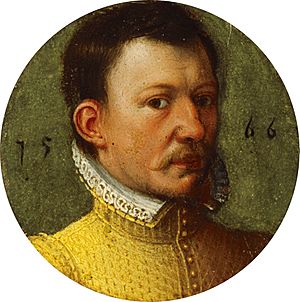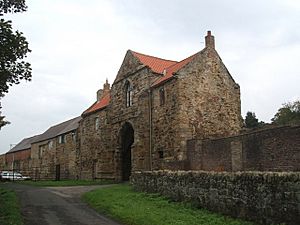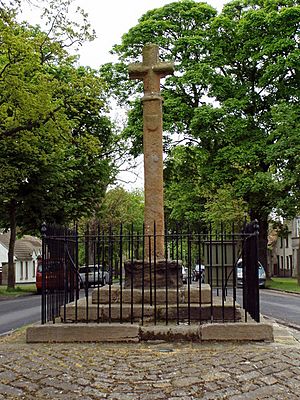John Cockburn of Ormiston facts for kids
John Cockburn (died 1583) was a Scottish landowner, known as the Laird of Ormiston. He lived in East Lothian, Scotland, and was an early supporter of the Scottish Reformation. This was a time when Scotland changed its main religion from Catholicism to Protestantism. John was the oldest son of William Cockburn and Janet Somerville. People usually called him "Ormiston."
Contents
A Scottish Protestant in Tough Times

John Cockburn was a strong Protestant. He also had good connections with England, even during a war called the Rough Wooing. This war was when England tried to force Scotland to agree to a marriage between their young rulers. John was forgiven for talking with the English during an attack on Edinburgh in 1544.
The famous Protestant leader John Knox taught one of John's sons. Another Protestant preacher, George Wishart, was captured at John's home, Ormiston Castle, on January 16, 1546. This was done by James Hepburn, 4th Earl of Bothwell, who was a powerful local leader. Soon after, soldiers from Scotland's leader, Regent Arran, arrived to arrest John, his nephew, and a friend. John and his nephew were put in Edinburgh Castle. But John managed to escape from the castle one morning by climbing over the wall!
John and his younger brother, Ninian Cockburn, were accused of being involved in the killing of Cardinal David Beaton in 1546. In September 1547, John is said to have helped the English army find their way to the battle of Pinkie. In January 1548, a list was published showing John Cockburn and 36 other Scottish landowners who had promised to be loyal to the English King, Edward VI. These people were known as "Assured Scots."
John and his friend, Alexander Crichton of Brunstane, tried to keep control of three houses for an English leader, Grey of Wilton. They hoped to capture Edinburgh Castle and hand over Scotland's leaders to the English. They also wanted the English to take over the Earl of Bothwell's home at Hailes Castle.
Scotland's leader, Regent Arran, captured John's home, the House of Ormiston.

John tried to defend another house called Saltoun, but his men did not have enough weapons. In February 1548, Arran attacked Saltoun with cannons. Five of John's men were killed, and five were captured and hanged. The Scottish government said John was a traitor on February 29, 1548, and ordered his home, Ormiston House, to be torn down.
John and his friend Crichton of Brunstane had to leave Scotland and live in England. On March 25, 1548, the English government gave John £65 as a reward for his losses in Scotland. King Edward VI sent John a letter in March 1550, saying he still supported him, even though peace was made between Scotland and England.
Because he helped the Protestant cause, King Edward VI gave John Cockburn the lands and money from the Kepier Hospital in Durham, England, on March 13, 1552. John later sold all these lands by 1564.
Trouble at the Border
John probably found it difficult to live in England when Mary Tudor became Queen, as she was Catholic. In April 1555, he tried to return to Scotland without the right papers. He was arrested by the Captain of Norham Castle and became a prisoner. The English government was interested in his case and the large amount of money he was rumored to be carrying. John was also said to owe money from the Durham Hospital, as Queen Mary was taking back properties for the church.
John was moved to the Fleet Prison in London. He finally appeared before the government on December 22, 1555. His crime was called a "border treason." John was forgiven and allowed to try and get his money back, but he decided not to.
The Scottish Reformation Crisis
The Scottish Parliament had declared John a traitor on December 5, 1548, because he helped the English and kept the House of Saltoun. However, on December 5, 1558, this decision was reversed. The Parliament said the process was wrong because John was out of the country at the time. His friend Crichton of Brunstane also had his traitor status removed on the same day.
During the big changes of the Scottish Reformation, John, the Laird of Ormiston, led his followers to face French troops at Cupar Muir in June 1559. On October 31, 1559, he was involved in a big problem for the Protestant Lords of the Congregation. Ormiston rode to Berwick upon Tweed and brought a large sum of money from England to help the Protestants fight the French soldiers in Scotland. However, the Earl of Bothwell attacked him near Haddington and took the money after a sword fight. John was left with a wounded face. This caused problems for England, as it showed they were helping the rebels against the Scottish Queen's mother, Mary of Guise.
In 1562, an English diplomat named Thomas Randolph asked the Scottish Queen Mary to fully restore John as the Laird of Ormiston. Randolph visited Ormiston on December 30, 1562, and wrote a letter from there to his boss, William Cecil.
Randolph later listed John among those who helped in the killing of Queen Mary's Italian secretary, David Rizzio, in March 1566. Two of John's relatives, his son-in-law and his nephew, were also listed, along with John Crichton, the son of his friend. However, two other sources from that time say that John Cockburn actually supported Queen Mary and Bothwell at the battle of Carberry Hill in 1567.
In April 1571, Thomas Randolph wrote to John Cockburn, saying he heard that John's son, Alexander, who was a student, was doing well.
John Cockburn had a stroke on the main street of Edinburgh on November 22, 1583, and he died.
Family Life
By 1535, John married Alison Sandilands (died 1584). She was the daughter of Sir John Sandilands. John's family symbol, a shield with a checkered band and three roosters, was carved at Mid Calder Church in 1541.
A religious book called Confession of Faith by Henry Balnaves was dedicated to Alison Sandilands. Balnaves wrote the book while he was a prisoner in 1548. The book was published in 1584. The publisher said that Alison and John Knox's secretary found the book's original papers with a child at Ormiston.
John and Alison had several children, including:
- Alexander Cockburn (born June 13, 1536 – died September 1, 1563). His travels and achievements are recorded on a metal plate at the National Museum of Scotland.
- John Cockburn, who became the Laird of Ormiston after his father. He was knighted in 1590 and was a member of the Scottish government. He married Janet Home.
- Samuel Cockburn of Templehall, who married Elizabeth Douglas. He went to England as an ambassador in 1583. Elizabeth Douglas was a poet.
- Sybil Cockburn, who married William Sinclair in 1566.
- Alison Cockburn
- Barbara Cockburn (died November 1610), who married George Hamilton.
Later Family
- John Cockburn of Ormiston (around 1679–1758) was a later family member who was important for improving farming in Scotland in the 1700s.


